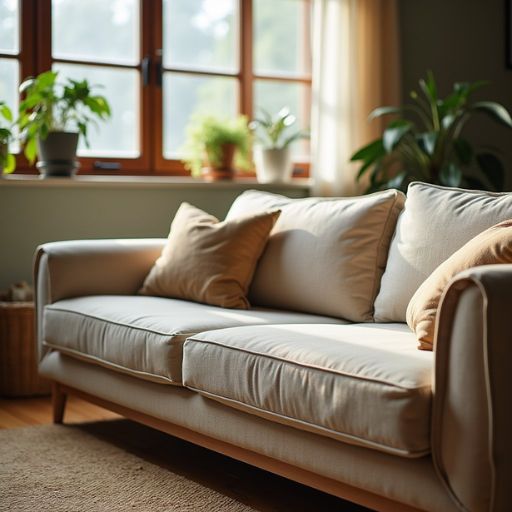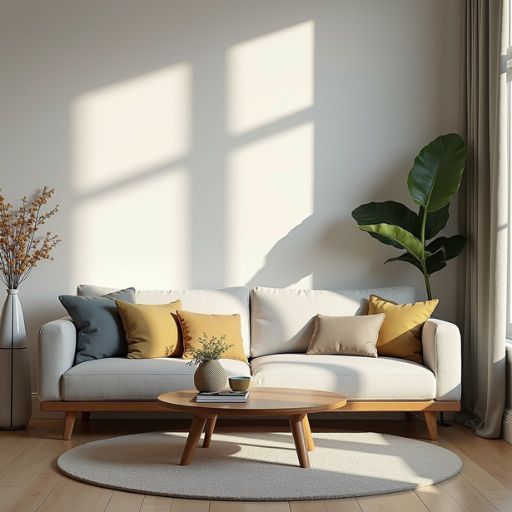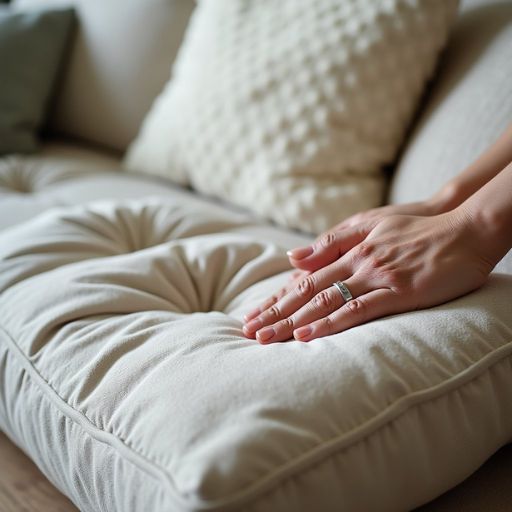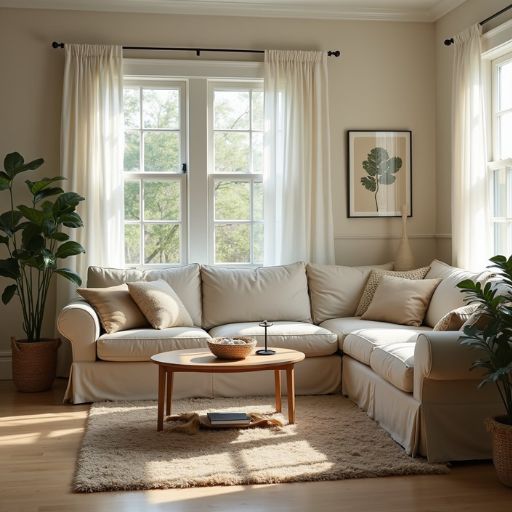15 Hidden Dangers Lurking in Your Upholstery (Warning: Check #7 Now!)
Studies show that the average sofa contains over 2 million microscopic dust mites feeding on the dead skin cells you shed daily.
While you’re relaxing on your favorite upholstered furniture, you might be sharing space with more than just these invisible creatures.
Your cozy couch could be harboring a host of hidden hazards that affect your family’s health, from toxic chemical treatments to potentially dangerous mold colonies.
Before you settle in for your next movie night, you’ll want to discover what’s really living in your living room—and what you can do to protect yourself from these lurking threats.

Dust Mites and Allergen Colonies
Microscopic invaders lurk within the fibers of your upholstered furniture, with dust mites leading the charge as primary colonizers.
These tiny arachnids thrive by consuming your dead skin cells and multiplying rapidly in warm, humid environments.
You’ll find highest concentrations in areas where you spend extended periods, particularly chairs and sofas.
What’s truly concerning isn’t just the mites themselves but their waste products and decomposing bodies, which become potent allergens.
These particles trigger respiratory issues, skin reactions, and can worsen asthma symptoms.
Your upholstery’s deep fibers create perfect microclimates for these colonies to flourish, especially when humidity levels exceed 50%.
Without proper intervention, a single piece of furniture can harbor millions of mites, making immediate action essential for maintaining your indoor air quality and respiratory freedom.
Toxic Flame Retardant Chemicals

Historically, manufacturers have incorporated synthetic flame retardants like polybrominated diphenyl ethers (PBDEs) and organophosphates into upholstery foam and fabric treatments.
You’re likely sitting on these chemicals right now, as they’ve been standard in furniture manufacturing since the 1970s.
These toxic compounds don’t stay locked in your furniture – they migrate into household dust and enter your body through inhalation, ingestion, and skin contact.
Research links PBDEs to thyroid disruption, neurodevelopmental issues, and certain cancers.
Even more concerning, your body can store these chemicals for years.
You’ll find these retardants in older furniture pieces, but even newer items aren’t guaranteed to be safe.
While some manufacturers have phased out PBDEs, they’ve often replaced them with equally questionable substitutes that haven’t been thoroughly tested for long-term health effects.
Black Mold Growth
Beyond chemical concerns, upholstered furniture harbors another significant health risk: black mold colonization.
When your upholstered items absorb moisture from humidity, spills, or flooding, they create an ideal breeding ground for Stachybotrys chartarum and other toxic mold species.
You’ll notice black mold through its musty odor and dark spots, but by then, it’s often deeply embedded in your furniture’s padding and backing.
This invasive fungus releases mycotoxins that can trigger respiratory issues, headaches, and chronic fatigue.
Don’t let manufacturers’ stain-resistant claims fool you – these treatments don’t prevent mold growth in damp conditions.
To protect your freedom to breathe safely, maintain indoor humidity below 60%, address spills immediately, and inspect furniture regularly, especially in basements and humid areas.
Pet Dander Buildup

Pet dander poses three distinct threats to upholstered furniture: allergenic proteins, microscopic skin cells, and persistent hair fragments.
These particles penetrate deep into your furniture’s fibers, creating an invisible reservoir of allergens that can trigger respiratory issues and skin reactions.
You’ll find that even homes with a single pet can accumulate significant dander deposits within 3-6 months.
When you sit on affected furniture, you’re releasing these particles into the air, where they remain suspended for hours.
The proteins in pet dander are particularly problematic because they’re sticky and cling tenaciously to fabric surfaces.
Don’t wait for symptoms to appear.
Regular vacuuming with a HEPA filter removes up to 85% of surface dander, but you’ll need professional cleaning to extract deeply embedded particles from your upholstery’s inner layers.
Chemical Off-Gassing
Toxic fumes emanating from new upholstery materials can persist for months after purchase.
These volatile organic compounds (VOCs) include formaldehyde, flame retardants, and stain-resistant chemicals that continuously release into your living space.
You’re breathing these chemicals while sitting, sleeping, or relaxing on treated furniture.
Your upholstery’s chemical treatments can trigger respiratory issues, headaches, and skin irritation.
The most concerning compounds are PBDEs (polybrominated diphenyl ethers) and PFAS (per- and polyfluoroalkyl substances), which don’t break down easily in your body or the environment.
You’ll find these particularly prevalent in stain-resistant and flame-retardant treatments.
To protect yourself, opt for natural materials like untreated cotton, wool, or hemp.
You can also accelerate off-gassing by increasing ventilation and using activated charcoal filters near new furniture pieces.
Bacteria From Food Spills

Food contamination on upholstery creates an ideal breeding ground for harmful microorganisms.
When you spill food or beverages on your furniture, bacteria multiply rapidly in the warm, moist environment between fabric fibers.
Common organisms like E. coli and Staphylococcus can survive for weeks in these conditions.
You’ll find that even small, unnoticed spills pose significant risks.
Bacterial colonies don’t just remain on the surface – they penetrate deep into padding and backing materials, where they’re protected from routine cleaning efforts.
They’ll continue to thrive and spread, potentially causing respiratory issues and skin infections.
To protect yourself, you’ll need to address spills immediately with antimicrobial cleaners.
Don’t rely on standard fabric cleaners alone, as they won’t eliminate all bacterial threats.
Consider applying fabric protectors that resist liquid penetration and bacterial growth.
Cancer-Linked Fabric Treatments
To protect yourself, you can opt for untreated furniture or choose pieces with natural stain-resistant fabrics like wool or leather.
You’ll also find safer alternatives using plant-based water repellents or physical barrier treatments.
Hidden Insect Infestations

Beyond chemical treatments, your upholstered furniture can harbor unwanted guests that pose different health risks.
Common invaders include dust mites, bedbugs, and carpet beetles that burrow deep into fabric fibers and padding.
You won’t typically spot these pests with the naked eye, but they’ll leave telltale signs like tiny dark spots, shed skins, or unexplained bites on your body.
These insects thrive in dark, warm environments and feed on dead skin cells, fabric fibers, and organic debris.
They’re particularly drawn to natural fibers like wool and cotton.
You’ll need to inspect your furniture regularly, especially in seams and crevices where they congregate.
A professional inspection can reveal the full extent of an infestation, while regular steam cleaning at 130°F (54°C) will eliminate most insect populations and their eggs.
Trapped Moisture Problems
Moisture trapped inside of upholstered furniture creates an ideal environment for mold and mildew growth, potentially leading to serious health concerns.
You’ll find these problems particularly in high-humidity areas or after liquid spills that haven’t thoroughly dried.
Your upholstery’s foam padding acts like a sponge, retaining moisture that can’t easily escape.
When the relative humidity exceeds 60%, microorganisms begin to thrive within 24-48 hours.
Don’t ignore musty odors – they’re warning signs of developing fungal colonies.
To protect yourself, you’ll need to act quickly after spills, using extraction methods to remove deep moisture.
Consider investing in a moisture meter to detect hidden dampness before it becomes problematic.
Installing dehumidifiers in your living spaces and maintaining proper ventilation will help prevent these moisture-related issues from compromising your furniture and health.
VOC Emissions

Volatile organic compounds seep out from within upholstered furniture, releasing a mixture of potentially harmful chemicals into your indoor air.
These VOCs originate from synthetic fabrics, flame retardants, stain-resistant treatments, and adhesives used in manufacturing your furniture.
You’ll find the highest VOC concentrations in newly purchased pieces, with emissions gradually decreasing over time through a process called off-gassing.
However, some chemicals continue releasing for years.
Common VOCs in upholstery include formaldehyde, benzene, and toluene, which can trigger respiratory issues, headaches, and skin irritation.
To protect yourself, you can opt for low-VOC certified furniture, choose natural materials like cotton or wool, and guarantee proper ventilation.
An air quality monitor will help you track VOC levels and determine when additional ventilation is needed.
Accumulated Dead Skin Cells
Every hour, your body sheds thousands of microscopic dead skin cells that settle deep within upholstery fibers, creating an ideal breeding ground for dust mites and microorganisms.
You’ll find these invisible particles accumulating in your favorite chairs, sofas, and mattresses at an alarming rate – up to 1.5 grams per day.
This biological debris combines with moisture from your skin and ambient humidity, forming a fertile environment that can host up to 10 million dust mites in a single piece of furniture.
Your accumulated skin cells don’t just feed dust mites; they decompose into fine particulate matter that you unknowingly inhale.
This can trigger allergic reactions, respiratory issues, and skin irritations.
Regular professional cleaning and maintaining humidity levels below 50% will help control this hidden biological hazard in your upholstered furniture.
Contaminated Stuffing Materials

While dead skin cells accumulate on the surface of your furniture, the internal stuffing materials harbor their own set of risks.
Your upholstery’s filling can contain toxic chemicals, including formaldehyde, flame retardants, and volatile organic compounds (VOCs) that continuously off-gas into your living space.
You’ll find these hazardous substances particularly concentrated in older furniture pieces, where manufacturers weren’t required to meet today’s safety standards.
Even natural filling materials aren’t immune to contamination – they can absorb moisture, leading to mold growth and bacterial colonization deep within the cushions.
You’re especially vulnerable to these contaminants when your furniture’s protective barrier becomes compromised through tears or worn seams, allowing direct contact with potentially harmful stuffing materials.
Testing kits can help you identify chemical exposure levels in your upholstery’s internal components.
Spilled Cleaning Product Residue
Spilled cleaning products pose a persistent chemical hazard in upholstered furniture, often leaving behind concentrated residues that penetrate deep into the fabric layers.
You’ll find these chemical traces can remain active for months, creating potential skin irritants and respiratory triggers when you least expect them.
What’s particularly concerning is that you can’t always see these residues, as they’ve soaked into lower fabric layers where they continue to off-gas harmful compounds.
Your furniture’s padding acts like a chemical reservoir, slowly releasing these substances into your living space.
Watch for tell-tale signs: unexplained odors, discolored patches, or areas where the fabric feels stiff or crusty.
If you’ve recently had upholstery cleaned, you’ll want to guarantee thorough extraction and ventilation to minimize residual chemical exposure.
Indoor Air Pollution Sources

Beyond chemical residues from cleaning products, your upholstered furniture can harbor multiple indoor air pollution sources that compromise air quality.
Your furniture’s foam padding releases volatile organic compounds (VOCs) through a process called off-gassing, while flame retardants embedded in the materials continuously emit toxic particles into your breathing space.
You’ll find that dust mites and their waste products accumulate deep within the upholstery fibers, becoming airborne whenever you sit down.
Pet dander, pollen, and mold spores also settle into the fabric’s weave, creating a reservoir of allergens that circulate through your home’s air.
Additionally, the synthetic materials in modern upholstery can react with ozone, generating secondary pollutants like formaldehyde and acetaldehyde that you unknowingly inhale throughout the day.
Formaldehyde Release
Formaldehyde emissions from upholstered furniture pose a significant health risk, particularly in newly manufactured pieces.
When you’re exposed to this colorless gas, you’ll notice symptoms like eye irritation, respiratory issues, and headaches.
Your furniture’s foam padding, adhesives, and fabric treatments are primary sources of these emissions.
You can protect yourself by checking furniture labels for formaldehyde-free certification and opting for pieces that use natural materials.
If you’ve recently purchased new upholstered furniture, you’ll want to ventilate your space thoroughly for several weeks.
The emission levels typically peak during the first few months after manufacturing and gradually decrease over time.
Consider testing your indoor air quality with a formaldehyde detection kit to monitor your exposure levels and guarantee you’re maintaining a safe living environment.
FAQs
How Often Should Professional Upholstery Cleaning Be Done for Maximum Safety Benefits?
You’ll want to schedule professional upholstery cleaning every 12-18 months, though high-traffic homes require service every 6-8 months. If you’ve got allergies or pets, consider quarterly cleanings to maintain ideal safety standards.
Can Air Purifiers Effectively Remove Toxins Released From Contaminated Upholstery?
Like a sentinel on guard, your air purifier can effectively trap some upholstery-released toxins through HEPA and activated carbon filters. However, you’ll need proper ventilation and regular filter changes for ideal protection.
What Natural Alternatives Exist for Treating Upholstery Without Harmful Chemicals?
You can treat upholstery naturally using vinegar, baking soda, essential oils, or steam cleaning. These chemical-free methods effectively remove stains and odors while maintaining your furniture’s integrity and protecting your health.
Are Leather Furniture Pieces Less Likely to Harbor Dangerous Substances?
Like a protective shield, leather repels many harmful substances. You’ll find genuine leather furniture’s non-porous surface won’t trap chemicals and allergens like fabric does, but it’s still wise to maintain regular cleaning protocols.
Do UV Sanitizing Devices Work Effectively on Deep Upholstery Contamination?
UV sanitizers won’t effectively penetrate deep upholstery layers, as their effectiveness diminishes beyond surface level. You’ll need professional deep-cleaning methods or steam treatments to address contamination that’s embedded within your furniture’s core materials.
Final Thoughts
You’ve seen the alarming evidence: your upholstery isn’t just a comfortable seat—it’s potentially a chemical cocktail threatening your family’s wellbeing.
Like a silent sentinel, these hazards accumulate while you’re unaware. Don’t wait until health issues emerge.
Take control now by implementing regular inspection protocols, professional cleaning schedules, and air quality monitoring.
Your furniture’s hidden dangers require immediate, systematic attention for peak household safety.